Author: Thais Waisman, MD,MBA
Institution: PUC SP Communication and Semiotics Department
This paper has the objective to discuss why Distance Learning is not being used so hard in the Corporate Universities in Brazil and why this method can be effective or not, analyzed by the communication stand point. Distance learning and Internet is a matter of communication issue and the corporations have to start to understand that. The key point is how the information is being transmitted or being spread out among the employees and how they are making some use of this information at all.
Talk about learning without mention the classics communication theories, specially how men learn from the universe is a contra sense.
Besides this, another discussion is the limitation of distance learning in adult education in the companies regarding to the low profile knowledge level of the majority of the workers in Brazil ( most of them had conclude no more than the 4th grade K 4), so how to introduce distance learning to this audience. This research has a focus on Corporate Universities in Brazil and some other environments and efforts to bring ODL to the companies. The corporations in Brazil have faced problems as how to provide some information regarding to the mayor number of employees and the challenge here is find a way to reach the employees with low profile learning level and which are the work force, basically.
This huge universe of people undergratuated that need more training, more qualification and support than any other but the methods are not quite well define around the world a global discussion.
We propose some methods and explain how they are been used in Brazil and its results.
Most of the Corporate Universities in Brazil havent started with distance learning yet, because most of them are not on line companies. The workers, specially those in the front line dont have computers or lap tops. Most of the office work force dont have internet access because of international policies, most of the time. This situation becomes things very difficult because how shall we deliver the internet products?
Actually, only 14 million thousands Brazilian people have access to computers and only 10 million thousands have internet access. Most of the users are men, in the age of 24 to 49 and surf from home.
Internet communication tool is not only publishing contents in html format, but much more than that. It is a new communication sign and language that have been growing with the new signs have been invented too.
To get into the corporations, the way we believe is sharing the interest through live virtual communities. The employees will find a reason to be a frequent custom of this new media tool if they feel a need of it.
The pay off can be time, locomotion, fast learning, availability, career path or other one.
We believe in synchronous tolls the best way to built virtual communities and to maintain those, just because exchanging information is the information way to spread out the knowledge. People learn by the perception method, as Pierce mentioned, or more simple and precise, in a triangle perception of the world: something (information, content, image, situation, an object in a very wide perspective) gets in touch with the mind, generating an idea that becomes the first object into another object because the first one is being modified according to my perception and my life experience. At the end, every time a new thing comes out, the human being have the ability to transform it and add his life on it, that is how we move the world and let the world know what and how we think it. It is very philosophical, but also very true.
There isnt another way to reach these worker instead of finding what they have in common, why this people would be loyalty to this specific product just because philosophically the are connected to the subject it is being discussed. The reason can be various: promotion career, qualification, competition, need of information, time dependent, geography limitation but in the bottom line the need (doesnt matter which one) is the reason that will keep this people connected and a kind of fidelity to this product.
"The corporations in Brazil and the distance learning: the internet access, the learning and the unversities.
In the corporations, the need of frequent training to be more competitive in the market is a goal, but far away from most of the corporations. Distance learning by Internet could be a solution if the employees had access to internet.
Brazilian scenario
Politics and economy the bad economy this country has had made the number of unemployed people grouwth during the last decade and a lost in the power to consume among the population. This people need more qualification or requalification to get into the market and get competitive again. How to train and grwoth a country with 169 million people?
- Some numbers:
- unemployed people - 7,15% (DIEESE augus,2000).
- Workers in the industrial sector 31,2% in 1990 and 19,6% in 199
- service is responsible for 21,6% economy during 1990 à 1999
- productivity gain per employee from 1991 to 1998 - 2,5%
The workers are wondering more opportunity to better upgrade their skills and competencies and be more productive
Tecnology ODL depends totally form technology and all sort of media. The communication is the key point to transmit and spread out these information, because any effort will be enough if the worker, at the other side, dont feel understandable and cant get what is being touch it is a matter of communication and the way this tool and this media will be used. It is too difficult and quite impossible think about where the technology will be in a few months, but the world tendency is the media convergence, in a clever way of it, reaching people wherever they are, in the conditons they have and respecting each one style, way of learning, media preferences.
More numbers that shows this stand:
- in Brazil, 94% of homes have TV
- 14 million people have computer, either at work or at home
- 10million people are connected to the internet.
Brazil is not an on line country, yet, but will be very soon.
Culture make people from the 50th accept the new ICT is a hard work, but the nature way ot let them in the ciberspace and understand the own order it has. This man has to move form the tangible world he lives and make a shift to this new one, where he is responsible for his acts and also has to understand the triadic mental process and forget a little bit the Cartesians, otherwise, he will try to reproduce the in the cyber world the same regular world or real world we live outside the computer world. This is the must common mistake and the one that makes most of the projects failed. If we dont accept that the language has changed, the way we learn and see the world has changes and the media we are using has its own language and communication standards, we will not get the advantages we should from the internet. The corporations cant pretend ODL is just translate word documents to HTML documents, is much more than that as we talked before.
Conclusion
- Brazil is still looking for the best way or, the way to do the best distance learning environment regarding to corporate actions
- Most of the corporate universities in brazil have few actions in the distance learning area
- Most of the companies dont have internet access to the work force
- Brazilian people dont have enough cultural approach to self learning training
- Brazilian people are very open to new technologies and to new environments, it is just a matter of time
- Most of the corporations are looking for partnership to universities or serious media labs to trust their projects and to start up the new learning era, because they already know that isolated actions will not survive and imported products have to become "brazilian" otherwise, no sense to consume those.
- Brazil is not an on line country yet, but will be very soon.
- Communication is the keys to afford success in any media choose and the language as a communication tool must be respected and understood in order to reach the learning objective and not only spent the budget in training.
- The money or the budget invested in the ODL implementation is the same or more than the one invested in the on site training.
- ODL is a power tool and must be used for professionals to professionals. It is not a computer game and it has to show results for itself.
Appendix
The graphics below show us the Brazilian reality.
1. number of PC and % of access
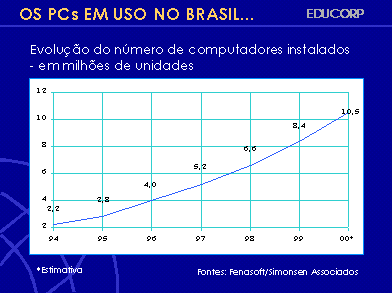
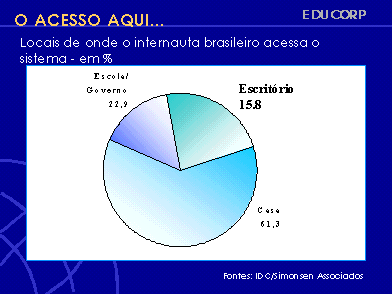
2. The internet users and the internet products
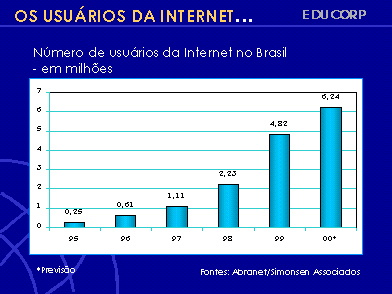
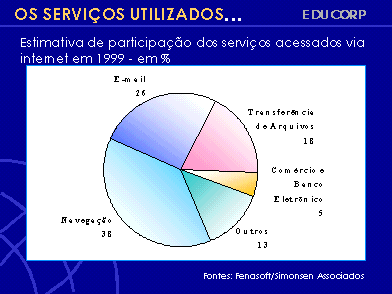
3. the age of the surfers and the education level
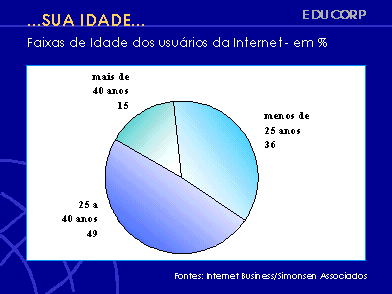
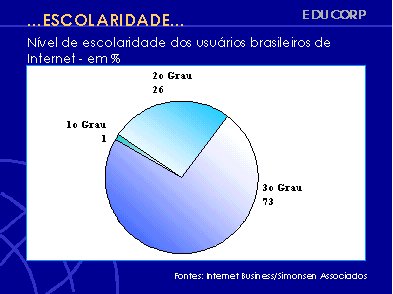
4. the social class and the next investing in technology
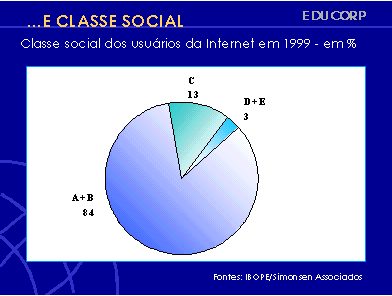
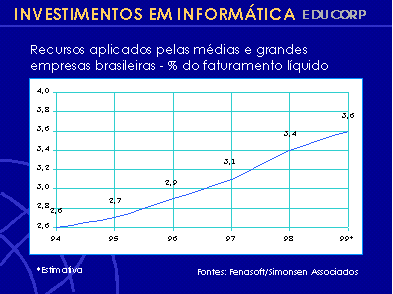
5. the cable TV and cellular phone installed
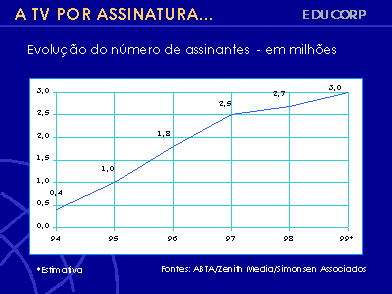
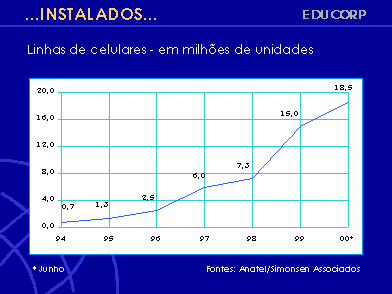
6. the fixed phone installed
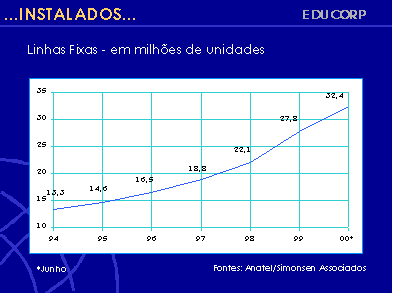
BIBLIOGRAPHY
CASTELLS, Manuel (1999)- A sociedade em rede - a era da informação: economia, sociedade e cultura, Editora Paz e Terra.
COLLIS, B. (1994).<<"On-line and Distance Education": A Reader.>> In http://www.to.utwente.nl/ism/online95/campus library/online94
CORTELLAZZO, Iolanda Bueno de Camargo. Computador para interação comunicativa. Comunicação e Educação. São Paulo, n. 16, p. 19-25, set./dez.,1999.
DAVENPORT & PRUSAK ( 1999 )Conhecimento empresarial Publifolha
DAVENPORT H. Thomas PRUSAK,L ( 1998 )Conhecimento Empresarial Como as organizações gerenciam seu capital intelectual - Campus
DAVIE, LYIN "Needed research in computer-mediated communication ( CMC) course design"
DE MASI, Domenico (1999) A sociedade pós industrial, Editora senac
GITMAN, Lawrence J (1997) Princípios de Administração Financeira 7a. edição, Editora Harbra
GOMES, M. R. (1996)."Animação, multimídia, realidade virtual, sistemas de informação geográfica: tecnologia ao serviço do homem?". In Tendências nº 1. Lisboa: APDC.
KLEIN, D ( 1998)A gestão estratégica do capital intelectual recursos para a economia baseada em conhecimento Qualitymark
KOTLER, Phillip (1998) Administração de Marketing, Análise, Planejamento, Implantação e Controle 5a. edição, Editora Atlas
LAS CASAS,Alexandre L. (1999) Administração de Vendas editora Atlas 5a. edição
-----------------(1999) Marketing para o século XXI edtora Futura
ALMEIDA, Maria José P. M.; SILVA, Henrique César da. Linguagem, leituras e ensino da ciência. Campinas, SP: Mercado de Letras, 1998.
LEVY, Pierre. A inteligência Coletiva. São Paulo: Loyola,1998.
----------------- Cibercultura, São Paulo: 34, 1999
-----------------O que é o virtual? , 1997
LOPES, A.M.; Machado, A.B. (1996).Que papel para a Telemática na Educação?". In Informática e Educação.(6)
MAIA, Carmem (2000). EAD.BR Educação a distância no Brasil na era da Internet Anhembi-Morumbi
MARIOTTI, Humberto (1999) Organizações de Aprendizagem Educação continuada e a empresa do futuro 2a. edição, Editora Atlas
MARTIN, Christopher (1999) Logística e Gerenciamento da Cadeia de Suprimentos 1a.edição, 2a. tiragem Editora Pioneira
MARTÍN-BARBERO, Jesus. Sujeito, Comunicação e Cultura. Comunicação e Educação. São Paulo, n.15,p.62-80, maio/ago.,1999.
MASON,R e KAYE,A "Mindwave: communication, computers and distance education"
MATTAR, Fauze Najib e SANTOS, Gabriel Dílson dos (1999) Gerência de Produtos como tornar seu produto um sucesso editora Atlas
MEISTER, Jeanne C. (1998) Educação Corporativa a Gestão do Capital Intelectual através das Universidades Corporativas Makron Books
MEISTER, J ( 1998)Educação corporativa a gestão intelectual através das Universidades Corporativas Makron Books
NEVES, André e Cunha, Paulo (2000). Projeto Virtus: educação e interdisciplinaridade no ciberespaço Editora Universitária UFPE
PORTER, Michel E. (1989) Vantagem Competitiva Editora Campus 16a. edição
PROUSAK e DAVENPORT (1998) Conhecimento Empresarial Editora Campus
VEIGA, P.(1996). "A Internet e a sua evolução para suporte à informação multimídia ".In Tendências, n.º 1. Lisboa: APDC. Vilmi, R.M. (1995).
www.fgv.org.br
www.ibge.org.br
www.inpe.org.br
www.institutomvc.com.br
www.pucsp.br
www.senacsp.org.br
www.vanzolini-ead.org.br
www.wbt.com.br
www.wtc.com.br
www.corpu.com










